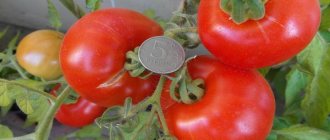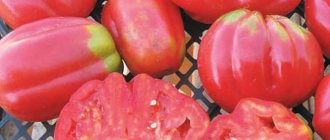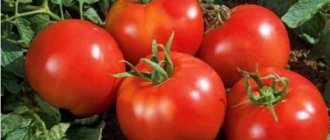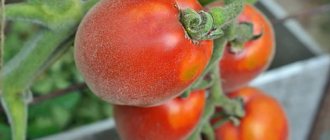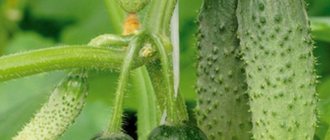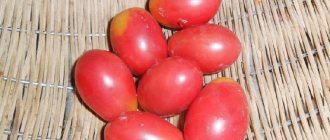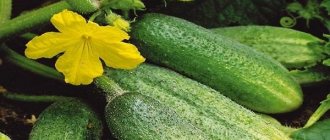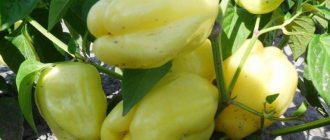The merit of Siberian breeding scientists is that they create crops that can survive safely and produce large harvests in the harshest conditions. The Siberian collection continues to be replenished with new varieties. For residents of the North, such breeding activities are especially important, because, unlike southerners, they do not have a huge variety of varieties.
The Pearl of Siberia tomato is relatively young, but has already become widespread due to its excellent taste characteristics and unusual shape of the fruit. Let's get acquainted with the general qualities of the variety and reveal the secrets of productivity.
Characteristics and description of the variety
The Pearl of Siberia tomato was born in 2009. This is not a hybrid crop , so it is not necessary to buy seeds for planting; gardeners collect them themselves from the largest fruits. The variety of Siberian breeders is excellent for breeding in regions with an unfavorable climate.
Distinctive features
The type is indeterminate, without limiting the growth of the main stem , so the plant needs staking. The height does not exceed 2 m, the foliage is moderate, the leaves are medium-sized, light green. The root system is powerful, branched, the inflorescences are simple. The first inflorescence is laid above the ninth leaf, the subsequent ones - every two leaves. Each fruiting branch produces 6–8 fruits.
The ripening period is average ; 115 days pass from the moment of germination to the full ripening of the fruit. The lower berries ripen first.
Productivity is high : 3 kg of fruits are collected from one seedling, from 1 sq. m remove 8-9 kg.
The tomato has proven itself to be highly resistant to the main diseases of the nightshade family. It is immune to late blight, gray mold and tobacco mosaic virus. The culture is recommended for cultivation in any region and takes root equally well in greenhouse conditions and in open ground.
Fruit characteristics
The weight of tomatoes reaches 100 g, the shape is elongated, pepper-shaped . The color of ripe vegetables is bright red. The pulp is fleshy, juicy, aromatic, the taste is sweet and sugary. There are many seeds, no more than three seed chambers. The peel is thin but durable, which allows you to transport ripe vegetables over long distances without losing their presentation and taste. Vegetables also have good shelf life.
The universal use of fruits allows for culinary versatility. Tomatoes are especially good in hot dishes, but also in fresh salads they perfectly complement other vegetables due to their subtle aroma.
When processed, delicious ketchups, adjika, sauces, lecho, juices and pastes are obtained from the fruits. Used for pickling and marinades.
The photo shows Pearl of Siberia tomatoes.
Description of Pearl tomatoes
The Pearl tomato has more than 5 different types, each worthy of special attention.
Description of Pearl tomatoes
Characteristic
Pearl is a relatively new type of tomato. It is grown both in greenhouses and in open ground, the main thing is constant watering and fertilization. This type of tomatoes is classified as decorative. The plant loves sunny and warm places.
The bushes are small in size, 30-40 cm. The growth of the plant at the time of ripening depends on the size of the pot in which the tomatoes are kept. Pearl tomatoes come in the following types:
- pearls of Siberia;
- yellow pearl;
- red pearls;
- pink pearl.
Features of the view
Each type from this family has a number of differences:
- productivity;
- unpretentiousness;
- excellent taste;
- Red color;
- resistance to diseases;
- ease of cultivation.
Pearl of Siberia
The Pearl of Siberia is a new type of tomato bred in this region. It is famous for its high yield and excellent taste. It is grown using seeds and is not a hybrid type. The Pearl of Siberia has a strong and strong root system, which makes it possible to grow in any conditions and still produce a good harvest; the entire system develops in width.
The bush grows to almost 145 cm, the stem is strong and powerful, and has several clusters with fruits. The leaves of this plant are small in size, shaped like potatoes, and dark green.
The variety gives good yield: on average, more than 8 fruits are obtained from one gem. Ripening is average, the first fruits are obtained after 110 days. The description of tomatoes is simple: they are round, tasty, and easy to grow.
The ripening process is interesting: first the lower and then the upper fruits ripen. The plant has good immunity, which facilitates the growing process
Red Pearl
This variety is suitable for growing at home
The fruits have a decorative basis; they are grown both in gardens and at home on the windowsill. The red pearl grows small, maximum 34-45 cm. The fruits are small, somewhat reminiscent of cherry tomatoes. One fruit weighs 25-35 g. The total number of chambers reaches 2, the percentage of dry substances is not higher than 6%.
The downside is that such tomatoes do not last long after assembly, so it is impossible to transport the product over long distances.
The variety perfectly combines acid and sugar. More than 1.5 kg is collected from one bush, and from 4 bushes per 1 sq. m receive over 6 kg. According to the description, the advantages of the variety are:
- the ability to grow tomatoes at home;
- fast ripeness;
- adaptability to lack of lighting;
- ability to withstand sudden temperature changes;
- resistance to diseases;
- ease of care.
Yellow pearl
Yellow pearls are mini tomatoes. The fruits of this garden crop are yellow. The plant is unpretentious and easy to grow. The main thing is to water it on time and sometimes give additional vitamins and fertilizers. Yellow pearl is a determinate hybrid.
The fruits ripen quickly, from the moment of planting to the moment of harvesting, 84-94 days pass. The plant is low: maximum height - 61 cm, minimum - 35 cm. It all depends on which parents are chosen for it. Mature fruits are bright yellow in color, round and small in shape.
The weight of one fruit is 20-35 g. It is recommended to tie the bushes to lighten the load on the plant. Positive characteristics of the variety:
- good resistance to lack of light;
- ability to withstand sudden temperature changes without loss of yield;
- high percentage of resistance to diseases and pests.
pink pearl
Pink Pearl is a determinate variety with early ripening. From planting to harvest it takes 82 to 86 days. The bushes grow small: 65-75 cm in height. Fully ripened fruits have a pinkish tint with red dots. Their weight ranges from 91 g to 95 g.
How to grow seedlings
Thanks to proper cultivation, seedlings grow strong and healthy. Care is simple and consists of following basic rules.
Seed preparation
Self-collected seed material needs more careful preparation than purchased seed. Initially, seeds are rejected in order to immediately dispose of non-viable specimens. The grains are laid out on the table one at a time and carefully inspected for visible damage. Then they check for emptiness inside. Prepare a saline solution from 1 teaspoon and 1 glass of water, place the seeds in it. Those unsuitable for landing will float to the surface after 10 minutes.
An important stage in the preparation of seed material is disinfection . The healthy growth and development of seedlings depends on this procedure. The seeds are disinfected in a weak solution of potassium permanganate for 25 minutes, then washed with running water.
Attention! A highly concentrated solution of potassium permanganate will destroy all seed material.
Before sowing, the seeds are soaked for 10 hours in a growth stimulator. The stimulator not only improves the germination rate, but also improves immunity. The drugs used are Epin, Zircon or Kornevin.
Container and soil
Any container for planting is suitable : when sowing in a common wooden box, you will need to pick the seedlings in the future. If the seeds are placed in individual containers, for example, disposable plastic cups or peat pots, further care of the seedlings is minimized.
The containers are pre-treated with a dark solution of potassium permanganate to protect the seedlings from fungal infections.
Fertile soil is prepared from garden soil mixed with peat, humus and river sand. River sand is added to make the soil lighter. The resulting mixture is mixed with a tablespoon of wood ash to saturate the soil with additional nutrients. The soil is spilled with a hot solution of potassium permanganate to destroy pathogenic flora. After the soil has cooled, it is laid out in planting containers.
Reference. In addition to its beneficial properties, ash serves as a neutralizer - it reduces the acidity of the soil.
Sowing
The seed material is sown to a depth of 1.5 cm , sprinkled with peat on top and lightly compacted. Moisten with warm, settled water from a spray bottle and cover the containers with film so that the seeds germinate faster. Before emergence, the room temperature should be at least +25 degrees.
How to sow tomatoes. Sowing tomato seeds for seedlings.
Seedling care
In a week the first shoots will appear . The containers are immediately moved to the windowsill, and the film is removed. If there is not enough light, the sprouts will stretch and weaken. To prevent this, install additional lighting.
Water as the top soil layer dries out. Use a shallow watering can and warm, settled water. After watering, the soil is loosened superficially to saturate the soil with oxygen.
When two true leaves appear, the seedlings are picked and placed in separate containers. During picking, weak and unhealthy seedlings are disposed of. The remaining plants are transplanted into separate containers along with a lump of earth.
Reference. When transplanted with a clod of soil, the plants quickly adapt to the new location.
If growth is poor, two weeks after picking, the seedlings are fed with liquid fertilizer for tomatoes.
10 days before transplanting into the ground, the seedlings are hardened off in outdoor conditions. To do this, it is taken out into the open air for 40 minutes, gradually increasing the time every day to 10 hours. The night temperature in the room is reduced to +13 degrees.
Tomato Pearl of Siberia
Description and characteristics of the tomato variety Pearl of Siberia, reviews, photos
Mid-early, indeterminate, productive, cluster tomato variety of Siberian selection.
The plant is strong, tall, with a powerful root system. The manufacturer recommends forming it into 1 stem, removing all side shoots (stepchildren). Medium sized leaf, light green. Inflorescence of intermediate type. Each cluster contains 7-9 fruits.
The Pearl of Siberia tomato is included in the State Register of the Russian Federation for growing under film covers in private household plots.
Basic qualities of fruits
The fruits are slightly elongated cream, smooth, red in color at ripeness, weighing 90-120 grams, excellent taste. Not prone to cracking, durable and transportable. These tomatoes are good for canning; they are also suitable for fresh consumption.
Originator : Agros.
Features of growing the Pearl of Siberia tomato, planting and care
We recommend sowing the seeds of this tomato variety for seedlings 60-65 days before the intended planting in the ground. Seedlings dive at the stage of two true leaves. When planting seedlings in a permanent place per 1 sq. It is recommended to place up to 4 plants per meter of land.
Further care for tomatoes consists of timely watering, fertilizing with complex mineral fertilizer, pinching and preventive measures to protect against diseases and pests.
When growing tomatoes in a greenhouse, we recommend installing a drip irrigation system - this will save your time and effort, as well as increase plant productivity and reduce the risk of late blight.
How to grow tomatoes
By the time of planting in the ground, the seedlings should have at least 5–7 true leaves and a formed root system.
Landing
Tomato beds are formed in a sunny place without draft winds. The soil is dug up in advance, adding humus.
Transplant on a cloudy day or after sunset into holes 20 cm deep with a distance of 50 cm between seedlings. Row spacing is formed at least 70 cm. With a smaller distance, plantings thicken, which increases the risk of developing fungal infections.
Other varieties of pepper tomatoes:
Pepper tomatoes for salads and canning
Tomato "Pepper robust"
How to grow a tomato Cio-Cio-san
After transplantation, the plants are left unattended for two weeks. During this time, they fully adapt to new conditions.
Further care
After rooting, the seedlings are watered regularly - at least twice a week with settled water. The water is kept in large barrels. Watering is carried out in the morning, since the daytime sun can burn the foliage.
Reference. If the barrels are exposed to the sun, the water will not only settle, but will also heat up. Warm water has a beneficial effect on tomato roots.
After watering, the wet soil is loosened and weeds with roots are removed. Loosening improves the air permeability of the soil, and weeding frees the beds from unnecessary vegetation. In addition, weeds often contribute to the development of fungal infections.
Mulching the holes helps them stay moist for a long time. This is especially important on dry days with high evaporation.
Tomatoes are fed with a complex of mineral fertilizers or organic matter . Feed at least three times per season: during flowering, formation of ovaries and at the time of fruiting. During flowering, they are fertilized with phosphorus elements, and during fruiting, potassium substances are added. At the moment of ovary formation, the tomato accepts organic matter well, for example, bird droppings or mullein infusion. The ratio of organic compounds to water is 1:15. With a highly concentrated solution, plant roots can get burned.
THE BEST FEEDING SCHEME FOR TOMATOES DURING FRUITING
Features of cultivation and possible difficulties
The bush is formed into one stem , removing all the lower leaves up to the first fruitful branch. Tomatoes are pruned regularly, once every 10–12 days, early in the morning, so that the wounds have time to heal by evening. To avoid infections, the cut sites are sprinkled with ash. Stepchildren are removed when they are 3–5 cm long. If longer shoots are removed, the seedlings will have a harder time withstanding the procedure.
The high growth of Pearl of Siberia tomatoes requires mandatory garter . When transplanting, a wooden or metal support is installed next to each seedling, and the main stem and branches are tied to it as they grow.
Another option is fixation on a trellis . Metal supports are installed on different sides of the beds and a wire is pulled between them, to which the stem and branches are fixed with fabric tapes. This method is less traumatic for plants.
Tomato variety “Pearl of Siberia”: photos, reviews, description, characteristics, yield
The desire of every gardener is to obtain a good harvest, regardless of climatic conditions and soil fertility. Thanks to the work of scientific breeders from Siberia, the tomato variety “Pearl of Siberia” was introduced to the market. The artificially bred variety guarantees consistently good yields, despite unfavorable weather conditions. Due to its good resistance to cold, the tomato is especially popular in northern regions, with a short and not too warm summer period.
Open ground tomatoes in Siberia:
Origin of the tomato variety “Pearl of Siberia”
The “Pearl of Siberia” tomato is the result of the work of breeders from the Siberian Federal District (Novosibirsk region). It received an official entry in the State Register of Russia for cultivation in greenhouses in 2009. The patent holder is agro.
Description of the variety
Fruit:
- Slightly elongated, cylindrical in shape, reminiscent of a dense thick barrel;
- Those that have not reached varietal maturity are pale green in color. As ripeness increases, they begin to turn brown and eventually acquire a bright red color;
- With smooth, dense, thin skin;
- Number of seed chambers 2-3;
- Average dry matter content;
- They reach approximately 10 cm in length;
- Average weight is from 100 to 120 grams.
Bushes:
- Indeterminate, non-standard plant. With a powerful branched root system and an abundantly leafy, strong stem;
- Reaches more than 1.5 meters in height;
- The leaves are medium-sized, potato-type, dark green in color, with a wrinkled structure;
- The inflorescence is simple, intermediate type. The formation of the first inflorescence occurs above the 9th leaf.
The best tomato varieties for the Urals and Siberia:
Tomatoes: advantages and disadvantages
The Pearl of Siberia tomato has a number of advantages:
- Low maintenance requirements;
- High productivity;
- Long-term fruiting;
- Pleasant taste characteristics;
- Ability for long-term storage;
- Resistant to cracking;
- Excellent immunity to common diseases and insect pests;
- Good transportability.
Application of fruits
The Pearl of Siberia tomato is distinguished by its versatility. Due to its sweetish taste with a slight sourness, the fruits are mainly consumed fresh. Tomatoes do not lose their beneficial qualities even after heat treatment. With whole-fruit canning, the fruits are not prone to cracking. They are also used to produce sauces, ketchups and juices.
Growing tomatoes
Experienced vegetable growers do not recommend sowing seeds directly into the ground, but using the seedling method.
How to prepare seeds:
- Before sowing, the seed material is disinfected and treated in a growth stimulator;
- It is advisable to sow seeds in germinated form. To do this, they are placed in damp germination material.
Sowing seed material:
- Seeds are sown for seedlings in early March;
- The soil for growing seedlings is disinfected and warmed to room temperature;
- You can choose any containers. But it is better to give preference to containers with a good drainage system;
- Planting material is sown at intervals of 1-2 cm, deepening by 1 cm;
- The planted seeds are covered with a film to create a certain humidity underneath;
- As soon as shoots appear, the film should be removed. To obtain strong seedlings, they are provided with good lighting. Therefore, additional lighting is used;
- Seedlings are picked as soon as two true leaves form;
- Water carefully, trying not to get water on the leaves. The seedlings are also fed with mineral fertilizers;
- To make the seedlings easier to adapt to new conditions, they are hardened off within two weeks.
Rules for planting seedlings:
- Tomato seedlings are transplanted to a permanent place when they reach the age of 50 days and a length of approximately 20 cm;
- The soil in the greenhouse structure is dug up with last year’s humus and treated with antimicrobial agents;
- Planting is carried out in planting holes located in a row, with an interval of 50 cm. The row spacing is maintained at approximately 70 cm;
- The planted bushes are watered at the root.
Bush care
How to care for tomato plantings:
- Water as needed with warm, settled water. It is necessary to make sure that moisture penetrates deep into the soil and nourishes the root system of the tomato crop. It is advisable to water in the morning. This will allow the plant to dry out at night when the temperature drops;
- Be sure to regularly loosen the soil to ensure stable air exchange. The frequency of the procedure is once every 3-4 days, after watering or precipitation;
- Mulch the soil not often. But if necessary, use black plastic, as this has a good effect on yield;
- The amount of fertilizing is determined by the type of soil. If there is fertile soil, feed the plantings four times during the growing season. It is permissible to use any complex of mineral fertilizers. When the soil is depleted, fertilizers are applied quite often. A deficiency of essential elements causes inhibition of tomato growth;
- Stepchildren breed once every 1.5 weeks. The formation of a bush is carried out in one stem;
- Gartering is a necessary procedure since the plant is quite tall.
Nuances for open ground and greenhouse conditions
In a greenhouse, plants reach 2 meters , while outdoor seedlings grow only up to 1.5 m. Therefore, the tops of greenhouse plants are pinched, artificially limiting their growth. Otherwise, nutrients will be spent on the growth and development of excess green mass, and the fruits will suffer from a lack of nutrients.
Closed structures are ventilated every day so that humidity and temperature do not exceed the norm. With high humidity, fungal spores quickly develop and greenhouse pests appear, which are dangerous for tomatoes.
Harvesting and application
Harvesting begins in July . The fruits should be picked slightly unripe, when they just begin to turn brown. Vegetables collected at this stage are stored for four weeks.
In cooking, they are used as much as your imagination allows . In hot dishes, the fruits of the Pearl of Siberia variety perfectly retain their taste. Their inherent subtle aroma is not lost in pickles and processed products: ketchups, adjika, pasta and juices.
During long-term transportation, ripe vegetables do not lose their presentation.
Diseases and pests
The Pearl of Siberia variety has high immunity to most diseases. However, if you do not follow the rules of agricultural technology, then it can fail. Especially in the second half of summer, when late blight fungi become active. To prevent defeat:
- regularly ventilate the greenhouse;
- carry out evening watering at least an hour before it closes for the night;
- weed and loosen the ridges;
- Tomatoes are periodically sprayed with antifungal drugs.
Among the pests, tomatoes, including the Pearl of Siberia, can be threatened by the mole cricket, especially if fresh manure was added when preparing the beds. If you notice wilted bushes that have practically no roots, then you should rush to the store for chemicals.
Advantages and disadvantages of tomato
Like every culture, the Pearl of Siberia has its pros and cons. The main advantage of the Siberian tomato is its cold resistance. Let's consider other advantages :
- ability to settle down in any region;
- strong immunity to diseases;
- high yield;
- the ability to form ovaries under any conditions;
- unpretentious care;
- unusual shape of the fruit;
- excellent taste;
- long-term storage;
- possibility of transportation;
- universal application;
- opportunity to collect seeds yourself.
The disadvantages include the mandatory staking of tall seedlings and regular pinching.
Farmer reviews
Positive reviews are the best indicator of quality . Here are some opinions of gardeners.
Maxim, Severodvinsk : “After several years of growing tomatoes, I realized one thing - the best variety for cool regions with short summers cannot be found. In addition, the tomato is disease resistant and easy to care for, which suits me quite well. I use the harvest to make preparations for the winter, and summer salads with it are very tasty.”
Lilia, Arkhangelsk : “The tomato is very tasty, it does not suffer from late blight. I chose it out of fear of losing the harvest from sudden cold weather, as often happens in our climate. I always plant a lot of tomato bushes, so it’s hard to see them destroyed by bad weather. With the Pearl of Siberia, there is never any doubt that the fruiting will be abundant and of high quality.”
Rules of care
Thanks to its unpretentiousness and high yield even in cold climates, the Pearl of Siberia receives only positive feedback from farmers. And if you put in a little effort, you can not only increase the yield up to 4 kg per plant, but also shorten the ripening period.
See also
Description of the tomato Tsarevna Frog, growing features
Read
